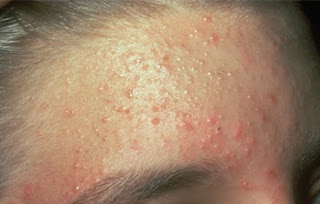Acne is one of the most common skin conditions seen by community based dermatologists. About 40-50 million Americans have acne at any point in time. It is estimated that 85% of teenagers will suffer from the condition; however, we are seeing it more commonly into adulthood, particularly in women. Women in the mid-20s and up tend to show a more "hormonal" pattern of acne in which it is distributed more on the chin, jaw, and chest.
The Causes
The disease process of acne involves four main components:
1. Excess sebum (oil)
2. Comedones (clogged pores)
3. Bacteria (specifically, Propionibacterium acnes)
4. Inflammation
Our body's production of sebum can make skin cells "stickier" so that they tend to clog pores instead of naturally rising to the surface of the pore and being shed from the body. This clogged pore is a wonderful environment for acne-causing bacteria to multiply. When our bodies identify these bacteria, immune cells are sent, which causes inflammation. The inflammation manifests as the red and swollen pimples and nodules.
Acne and Diet
Many have argued that milk, chocolate, sugar, and many other foods cause acne. No studies have definitely shown any one type of food to be associated with acne. There have also been thoughts that a lower glycemic diet can help alleviate acne through correction of insulin resistance; however, this too needs more research. This is the theory behind the Paleo/Hunter-Gatherer diet helping to clear acne. Acnenet offers a good review on this subject here.
Hormones, stress, and acne
Hormones (specifically androgens) cause acne by increasing sebum production. This is why teenagers get acne as they enter puberty. This is also why women tend to get breakouts around menstrual cycles and in times of stress. Any time hormone levels are fluctuating in a way which increases sebum, there is a higher risk of developing acne.
Other causes of acne
Having a family history also makes it more likely to suffer from the condition since we know it does tend to run in families. Much less commonly, acne may be caused by medications or other medical problems. Likewise, other medical conditions may resemble acne. These are reasons to be examined by a physician.
The Types
We often characterize acne into subtypes because our treatment options tend to vary according to the primary type of acne. The three main subtypes are:
1. Comedonal (blackheads)
2. Inflammatory (whiteheads/pus bumps and red bumps)
3. Nodulocystic (deep-seated "cystic" nodules)
 | |
| Blackheads, also called open comedones, on the chin |
 |
| Whiteheads (closed comedones), inflammatory papules and pustules (pus-bumps) |
 |
| Open comedones (blackheads) and pustules |
 |
| Severe, scarring, nodulo-cystic acne |
Some more good resources:
AAD: Acne
Acne Can Change the Way You See the World
Adult Acne: A Fact of Life for Many Women
Food Does Not Cause Acne
Stay tuned for Acne, Part II: Treatment, which is coming soon.
Lauren

No comments:
Post a Comment